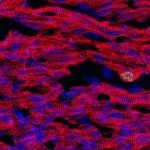Link to Pubmed [PMID] – 15130493
Dev Cell 2004 May; 6(5): 685-98
When and how cells form and pattern the myocardium is a central issue for heart morphogenesis. Many genes are differentially expressed and function in subsets of myocardial cells. However, the lineage relationships between these cells remain poorly understood. To examine this, we have adopted a retrospective approach in the mouse embryo, based on the use of the laacZ reporter gene, targeted to the alpha-cardiac actin locus. This clonal analysis demonstrates the existence of two lineages that segregate early from a common precursor. The primitive left ventricle and the presumptive outflow tract are derived exclusively from a single lineage. Unexpectedly, all other regions of the heart, including the primitive atria, are colonized by both lineages. These results are not consistent with the prespecification of the cardiac tube as a segmented structure. They are discussed in the context of different heart fields and of the evolution of the heart.



